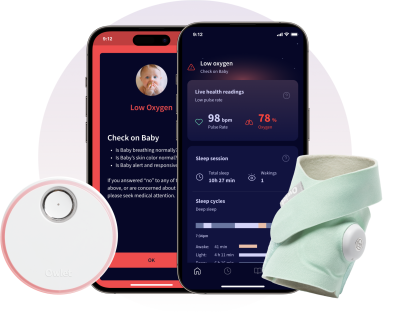Owlet is surely flying high after finally securing FDA clearance for its Dream Sock baby monitoring system that alerts parents and other caregivers if a child’s vital signs leave healthy ranges—a feature that previously landed the company in hot water with the regulator.
The system centers around a flexible, socklike device that wraps around a baby’s foot and is embedded with a sensor to track vital signs like pulse rate and oxygen saturation, while also monitoring their sleep length and cycles—and all of those data are wirelessly transmitted to an app on caregivers’ smartphones. The system is meant to be used on healthy babies between the ages of one to 18 months who weigh between six and 30 pounds.
And, while the Dream Sock has previously been available for purchase purely as a monitoring system for “sleep quality indicators,” the de novo clearance now allows real-time heart rate and oxygen saturation measurements to be displayed on the app and raises an alarm if those measurements leave a preset range.
The newly cleared features will begin rolling out to both new and existing Dream Sock users by the end of the year, according to Owlet’s Thursday announcement, in which the company classified the upgraded Dream Sock technology as “the first and only over-the-counter medical pulse oximetry solution for infants.”

“We’re all so proud that the Dream Sock was validated against the gold standards of accuracy for pulse oximetry devices—and stood up to that challenge,” said Alisa Niksch, M.D., Owlet’s senior director of medical affairs. “Throughout this process, we learned a tremendous amount about the capabilities of our product in supporting the care of babies in the home. We’re excited to continue our research efforts as we bring new technologies and advancements in accuracy in infant monitoring to parents.”
The FDA nod makes right a previous wrong that had sparked a warning letter from the agency in 2021 and ultimately led Owlet to take a similar monitoring system, then known as the Smart Sock, off the market.
For several years leading up to that point, Owlet had been selling the Smart Sock system—which included the automated oxygen saturation and heart rate alerts and could be used on children up to 5 years old—over the counter without any oversight from the FDA.
Though the company claimed that the technology didn’t need FDA clearance because it was meant to be used only for monitoring purposes, and not to “diagnose, cure, treat, alleviate or prevent any disease or health condition or investigate, replace or modify anatomy or any physiological process,” the agency argued that because the alerts could potentially be used to help diagnose conditions like desaturation and bradycardia, the system should indeed be classified as a medical device.
The FDA said at the time that it had been in correspondence about the purported misclassification since 2016, but it wasn’t until it sent the warning letter in October 2021 that Owlet removed the Smart Sock from the market and made plans to submit the technology for proper marketing authorization.
While awaiting the de novo clearance for the Dream Sock technology, Owlet racked up another FDA clearance earlier this year for another of its baby monitoring systems.
The BabySat system looks and works similarly to the Dream Sock, complete with health alerts, but differs in a few key areas. For one, unlike its over-the-counter successor, BabySat is available only with a doctor’s prescription. And, while Owlet has specifically noted that the Dream Sock is meant to help monitor healthy babies, BabySat is indicated for use by infants who have been diagnosed with acute or chronic medical conditions and are under a doctor's supervision.